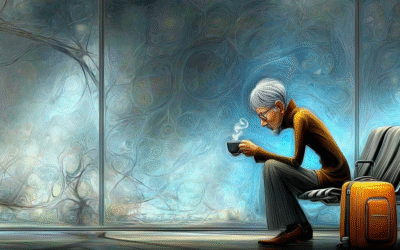When Donald Trump shared an AI-generated image of himself as the Pope—robed in white, radiant with divine suggestion—the image ricocheted through our collective consciousness like a cultural depth charge. It wasn’t just weird; it was precisely calibrated weirdness. The kind that demands reaction.
This papal performance art triggered immediate speculation about cognitive decline from critics, a diagnosis that merits careful examination. What we’re witnessing may instead reflect an intuitive grasp of what might be called the Spectacle Economy—a system where attention operates as both currency and commodity, where outrage generates capital, and where being misunderstood often serves strategic ends rather than indicating confusion.
The Alchemy of Outrage
Trump’s relationship with media resembles less a political strategy and more a form of performance art, sharing DNA with Andy Kaufman’s boundary-dissolving comedy, Duchamp’s provocative readymades, and the calculated shock tactics of the Sex Pistols. Each understood that in certain contexts, confusion itself could be weaponized.
What we’re witnessing isn’t random. It’s algorithmic alchemy—the transformation of outrage into attention, attention into influence, influence into power. The formula works something like this:
- Project an image so absurd it demands acknowledgment
- Watch as opponents expend energy responding
- Convert their outrage into visibility
- Reframe criticism as evidence of effectiveness
This pattern extends far beyond politics. It mirrors the attention economy that shapes everything from TikTok fame to academic citation indexes to corporate brand strategies. The marketplace of ideas increasingly rewards not what illuminates, but what inflames.
Media Ecosystems and Mimetic Behavior
Media theorist Marshall McLuhan observed that “the medium is the message”—meaning the container shapes the content. Trump’s tactics reveal an intuitive grasp of this principle. His communication style developed in perfect symbiosis with the evolving media landscape:
- Tabloid era: Bold claims, personal drama, simplified narratives
- Reality television: Conflict as entertainment, persona over person
- Social media: Reaction-harvesting, context collapse, tribalism
This isn’t simply adaptation; it’s co-evolution. Trump didn’t just adjust to these environments—he helped shape them, creating feedback loops where media platforms intensified the very behaviors they claimed to merely document.
The result resembles what biologist Richard Dawkins termed “memetics”—the spread of cultural units that replicate not because they’re true or beneficial, but because they’re optimized for transmission in specific environments. Trump’s provocations work like viral memes, designed not for accuracy but for propagation.
Cognitive Decline vs. Strategic Communication
Before dismissing accusations of cognitive impairment, it’s worth understanding what genuine cognitive decline actually looks like. Clinical neurology identifies several consistent patterns in those experiencing dementia or similar conditions:
- Progressive disorientation: Confusion about time, place, and context
- Language deterioration: Diminished vocabulary, increased word-finding difficulties, and simplified syntax
- Lost narrative cohesion: Inability to maintain a storyline or return to a point after digression
- Emotional dysregulation: Inappropriate affect, diminished impulse control unrelated to strategy
- Repetition without purpose: Repeating phrases without rhetorical intent or awareness
- Conceptual simplification: Loss of ability to understand or express complex, abstract ideas
What’s striking about Trump’s communication is how thoroughly it differs from this clinical picture. His speech patterns show:
- Consistent targeting: His provocations consistently hit politically advantageous targets
- Tactical repetition: Phrases repeated for emphasis and brand-building, not confusion
- Audience awareness: Adjusting message and delivery based on crowd reaction
- Strategic timing: Provocations often coincide with news cycles needing disruption
- Pattern persistence: Maintaining the same communication style across decades
This doesn’t mean his cognitive health should be beyond question—he is in his late seventies, an age where decline is common. But attributing his provocative communications solely to cognitive impairment misses their strategic function in the attention marketplace.
The Cognitive Science of Spectacle
Our brains evolved during times when attention was a precious resource allocated toward genuine threats and opportunities. The modern information environment hijacks these ancient mechanisms through what neuroscientists call “supernormal stimuli”—exaggerated versions of signals our brains are programmed to notice.
Just as a robin might exhaust itself trying to sit on an artificially large egg, our cognitive architecture responds disproportionately to content that triggers:
- Novelty detection: Something that violates expectations (a presidential candidate who “speaks his mind”)
- Threat assessment: Signals of danger (rhetoric of decline, invasion, corruption)
- Social information: Status cues and tribal markers (who’s in, who’s out)
- Pattern completion: Partial information we rush to fill in (often incorrectly)
Trump’s Pope image hits all these buttons simultaneously—it’s novel, it triggers both religious and political pattern-matching circuits, it prompts social positioning, and it leaves cognitive gaps we scramble to fill with meaning.
The Half-Life of Outrage
But there’s a problem with spectacle as strategy: diminishing returns. Like a medication that requires ever-increasing doses, shocking content must continually escalate to maintain effectiveness. The neurological mechanism responsible is called “habituation”—our brains’ tendency to pay less attention to repeated stimuli.
We’ve seen this pattern play out across domains:
- Advertising: From subtle product placement to increasingly outrageous shock tactics
- Entertainment: The progressive intensification of reality TV conflicts
- News media: The evolution from “if it bleeds, it leads” to “if it outrages, it engages”
The trajectory suggests an inevitable endpoint: what communications theorists call “semantic satiation,” where words and images lose meaning through repetition. The AI Pope image exists in this twilight zone—still strange enough to circulate, but following a now-familiar pattern.
Beyond Diagnosis: Cultural Prognosis
The impulse to pathologize Trump’s behavior—to diagnose it as dementia rather than strategy—reveals our collective discomfort with accepting the implications of this media approach. It’s easier to dismiss provocative communication as illness rather than confront what it reveals about our information ecosystem. This tendency exists on both sides: supporters who refuse to acknowledge problematic speech patterns and critics who default to medical explanations for political behavior they find objectionable.
A more nuanced assessment recognizes both the limitations that age imposes on all septuagenarians while acknowledging that strategic media manipulation and cognitive decline are distinct phenomena with different markers. The characteristics that define Trump’s communication—its consistency, tactical timing, and audience awareness—stand in contrast to the clinical progression typically seen in degenerative conditions.
What we’re witnessing isn’t an anomaly but a culmination—the logical endpoint of communication environments optimized for engagement rather than understanding. The spectacle isn’t the exception; it’s increasingly the rule.
This pattern transcends individuals and even politics. We see parallel dynamics in:
- Corporate publicity stunts designed to provoke rather than persuade
- Influencers manufacturing controversy for visibility
- News organizations prioritizing reaction over information
- Celebrity feuds orchestrated for mutual benefit
All operate within the same attention marketplace, trading in the same currency of engagement, participating in the same economy of outrage.
The Post-Spectacle Possibility
The final irony may be that spectacle eventually undermines itself. Habituation doesn’t just reduce response to individual provocations—it can extend to the entire mode of communication. Just as audiences eventually tired of shock radio, reality TV excesses, and clickbait headlines, the perpetual outrage machine faces the threat of collective exhaustion.
What comes after the Spectacle Economy? History suggests several possibilities:
- Return to authenticity: A renewed premium on sincerity and substance
- Sophistication: More nuanced forms of attention-capture
- Fragmentation: Micro-audiences with specialized forms of engagement
- Withdrawal: Attention conservation as a cultural value
The oscillation between spectacle and substance resembles other cultural pendulum swings—between ornament and minimalism, cynicism and earnestness, complexity and simplicity.
Trump’s papal imagery isn’t evidence of confusion. It’s a mirror reflecting our own complex relationship with attention, meaning, and media. The question isn’t whether he understands what he’s doing, but whether we understand what we’ve built—an ecosystem where the image of a man who would be Pope becomes, however briefly, exactly that.



